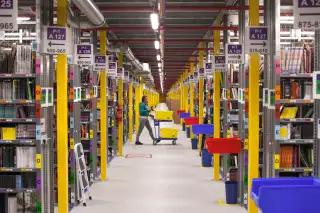The Reason You First Started Shopping at Amazon Is Disappearing

First and foremost in its rise to the top of retail, Amazon grabbed the attention of consumers simply by undercutting the competition on price. It started in the mid-'90s with books "priced close to cost, in order to increase sales volume," as an in-depth New Yorker story about the company put it. In lieu of profits on book sales, the business plan was this: "After collecting data on millions of customers, Amazon could figure out how to sell everything else dirt cheap on the Internet."
And that's pretty much what Amazon did. The Jeff Bezos aphorism "Your margin is my opportunity" became the unofficial Amazon mantra, and the world's biggest e-retailer competed ruthlessly on price. The advent of "showrooming"—in which shoppers scoped out merchandise in stores, then whipped out smartphones to see how much they'd save by purchasing it at Amazon—hammered home the idea that saving money was the biggest reason to do business with the world's largest e-retailer.
Why, then, does it seem that more and more consumers are grumbling that Amazon's prices aren't that cheap lately? In a thread on Reddit posted this week that's gathering a lot of attention, the initial commenter griped about Amazon's "pricing getting a little ridiculous," explaining, "Most of the stuff I'm trying to buy, from clothes to food, is way overpriced, sometimes marked up 100%."
Many of the 400+ comments that followed were in agreement that Amazon's prices aren't as cheap as they used to be. What's especially frustrating is that shoppers routinely see that prices for many items are higher if they qualify for free two-day delivery via Amazon Prime, which costs $99 per year. So in one way or another, consumers are getting the strong impression that shopping at Amazon isn't quite the savings proposition it once was.
This is hardly the first time that Amazon's status as the retail world's low-cost leader has come into question. During the 2014 winter holiday season, Amazon's online customer satisfaction ratings dropped significantly, and the overwhelming reason cited for the decrease is that pricing didn't meet up with consumer expectations. In many instances, Walmart had cheaper prices than Amazon.
Research released just after the holidays revealed some of the strategies behind Amazon prices: While the e-commerce giant tended to have the cheapest prices on the most popular items, prices for many other goods were far higher than what shoppers might find at Walmart and other retailers. What Amazon appears to be hoping is that, after seeing low prices on one or two popular items, customers are lulled into believing that the site has the cheapest prices for everything—and this is just not the case.
Based on the recent discussion at Reddit, though, more and more consumers are becoming aware that the competition may be able to beat Amazon on price. This could be a huge problem for Amazon—after all, low prices were what originally attracted most people to the site—but at the same time, it seems as if shoppers' main reason(s) for using Amazon are shifting.
Instead of always having the rock-bottom cheapest prices, Amazon now reliably has prices that are decent, if not the absolute lowest available. What keeps Amazon's sales humming along, then, is that it's convenient. The site that used to be all about saving money is now the Internet shopper's "prime"—pun intended—resource for saving time.
The importance of Amazon Prime cannot be understated in Amazon's quest to increase profits. Early on, Amazon discovered that Prime subscribers overwhelmingly made their online purchases via Amazon, and therefore they stopped shopping elsewhere. Naturally, a customer's Amazon purchases skyrocket once he or she is signed up for Prime. With the assurance of free two-day shipping on most purchases, and the assumptions that Amazon's prices are at least in the same ballpark as the competition, it might seem unnecessary for a Prime member to bother taking the time to shop around for a better deal.
What seems to be happening is that as more customers automatically, almost unconsciously turn to Amazon out of habit, convenience, and the desire to get the most out of one's $99 Prime membership, the door has opened and it has become easier for Amazon to raise prices.
When you look at it this way, that "free" shipping that comes with Amazon Prime might not seem quite so free.
Read next: 5 Ways That Amazon Is Still Far Superior to New Upstart Jet.com